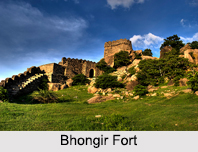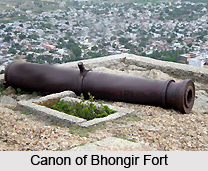 Bhongir Fort is one of the earliest forts in South India. This fort is located at Bhongir in Nalgonda District of the Indian state of Telangana. It was built during 10th century by Tribhuvanamalla Vikramaditya VI of Western Chalukya ruler. Bhongir Fort is also considered to be a popular spot among tourists. The fort is situated on a huge rock with a commanding height.
Bhongir Fort is one of the earliest forts in South India. This fort is located at Bhongir in Nalgonda District of the Indian state of Telangana. It was built during 10th century by Tribhuvanamalla Vikramaditya VI of Western Chalukya ruler. Bhongir Fort is also considered to be a popular spot among tourists. The fort is situated on a huge rock with a commanding height.
History of Bhongir Fort
The ruler of the Western Chalukya dynasty, Vikramaditya VI, built the fort from one single monolithic rock in the 12th century; as a result, the fort was originally named Tribhuvanagiri, after him. Gradually, across the centuries, the name metamorphosed into Bhuvanagiri and eventually, into Bhongir, its present name. The hill upon which the fort itself is built is about 500 feet high, and spread to about 40 acres of land.
 According to legend, Bhongir Fort once had an underground passage that leads directly to Golconda Fort. Bhongir Fort held its own armies against enemy but by the 15th century, with the advent of gunpowder, cannons had reduced its strategic importance. Then it finally went to the Bahmani Sultans who tried to renovate it, and thus, gave it an Islamic style. It became a seat to the local governor, and a prison for Qutub Shahi throne pretenders. By the 18th century, the fort has fallen into decay, and until today, it had just remained as a silent fortification in ruins.
According to legend, Bhongir Fort once had an underground passage that leads directly to Golconda Fort. Bhongir Fort held its own armies against enemy but by the 15th century, with the advent of gunpowder, cannons had reduced its strategic importance. Then it finally went to the Bahmani Sultans who tried to renovate it, and thus, gave it an Islamic style. It became a seat to the local governor, and a prison for Qutub Shahi throne pretenders. By the 18th century, the fort has fallen into decay, and until today, it had just remained as a silent fortification in ruins.
Structure of Bhongir Fort
Considered practically impregnable by invading armies then, the fort has a unique egg-shaped construction with two entry points that are protected by huge rocks. A moat encircles the fort and the place itself has a huge underground chamber, an armoury, stables, and trap doors, among others. The citadel located on the top of the hill gives a wonderful bird`s-eye view of the surrounding area.
Visiting Information to Bhongir Fort
Rajiv Gandhi International Airport and Bhongir Railway Station are the best mediums to reach the fort. The distance between Bhongir Fort and Bhongir Railway Station is 73.4 km. Bhongir Fort can also be reached by road via National Highway 16.



















